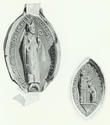 William de Bondington (fl. 1233-1258) is important as a major figure in the government of Scotland and as the builder of the third cathedral. Bondington was appointed chancellor by Alexander II in 1230 or 1231. After consecration as bishop he continued as chancellor, perhaps until Alexander's death (1249), and remained a member of the king's council until removed in a political upheaval (1255).
William de Bondington (fl. 1233-1258) is important as a major figure in the government of Scotland and as the builder of the third cathedral. Bondington was appointed chancellor by Alexander II in 1230 or 1231. After consecration as bishop he continued as chancellor, perhaps until Alexander's death (1249), and remained a member of the king's council until removed in a political upheaval (1255).
 Bondington acted as a papal judge-delegate on several occasions. He authorised the establishment of Crossraguel Abbey and was probably the bishop who brought the Dominican friars to Glasgow. Bondington continued the nave of the cathedral and was responsible for the existing choir (a grander setting for the liturgy and probably the shrine of St. Kentigern) and the lower church. The latter made an architectural feature of the saint's tomb, provided an elaborate lady chapel and created space for additional altars.
Bondington acted as a papal judge-delegate on several occasions. He authorised the establishment of Crossraguel Abbey and was probably the bishop who brought the Dominican friars to Glasgow. Bondington continued the nave of the cathedral and was responsible for the existing choir (a grander setting for the liturgy and probably the shrine of St. Kentigern) and the lower church. The latter made an architectural feature of the saint's tomb, provided an elaborate lady chapel and created space for additional altars.
 Bondington was a generous benefactor to the canons, granting them the church of Hutton, Berwickshire, as part of their common property, assigning the church of Peebles to the archdeacon of Glasgow as his prebend, providing for the free election of the dean by the canons, creating the office of chancellor and confirming to the chapter (all the dignitaries and other canons together) the liberties and customs of Salisbury Cathedral. Administration of the diocese was improved by the creation of a second archdeaconry.
Bondington was a generous benefactor to the canons, granting them the church of Hutton, Berwickshire, as part of their common property, assigning the church of Peebles to the archdeacon of Glasgow as his prebend, providing for the free election of the dean by the canons, creating the office of chancellor and confirming to the chapter (all the dignitaries and other canons together) the liberties and customs of Salisbury Cathedral. Administration of the diocese was improved by the creation of a second archdeaconry.
By 1255 Bondington was ailing and he spent much of his last years at Ancrum, Roxburghshire, the earliest evidence for an episcopal residence there. He died there and was buried at Melrose.